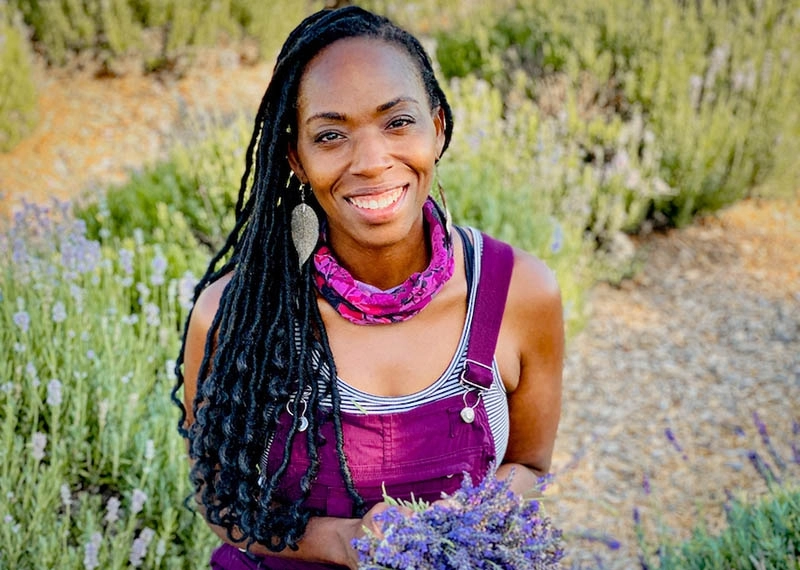
In this week after Veterans Day here in the US, and in this season clarifying that gratitude is one of the greatest gifts of the garden and the growing world, we’re in conversation with someone who knows this gift of the garden perhaps especially well. Zepherine - Zee – Hanson is an Air Force Veteran who after 8 years serving as a military photo-journalist took a medical retirement in 2004.
As part of her own healing journey, Zephrine joined the Veterans to Farmers turning protectors into providers, in Denver, CO. Working in partnership with the Denver Botanic Gardens, the therapeutic Veterans to Farmers program was life changing for Zephrine, bringing together all of the things she cared most about and motivating her to found her business Hamden Farms which connects farming, storytelling, small business incubation, underserved communities, and growing outside the box. For her innovative work researching how to connect unused farm produce to small makers looking to craft value add products- helping to stabilize the incomes of both farmers and makers, Zephrine has won awards and recognition from the Bob Evan Heroes to CEOs program, from LinkedIn Creator Accelerator Program, from REI, and more.
Farming led Hanson to pick up her cameras again and resume telling stories. She uses her communication skills to tell the stories of such organizations as Veterans to Farmers, Frontline Farming, the Black and Brown Growers Collective, the East Denver Food Hub and the farm business Sow Sistas.
“I came to farming for my mental health. I didn’t think I would get back to photography, storytelling, any of that,” Hanson said. “But it was another door that opened. I care about the challenges for veterans, for Black women, for people who are systematically underrepresented outdoors across the board.”
It took some time for Zephrine and me to connect, but as it turns out, we connected at just the right time and it is a great pleasure to be speaking with her at this exact time. Enjoy!
Follow Zephrine and her Hampden Farms online: https://www.hampdenfarms.com/ and on Instagram: @hampdenfarms
IF YOU LIKE THIS PROGAM,
you might also enjoy these Best of CP programs in our archive:
JOIN US again next week, when we are pay tribute to another gift of the garden – paying attention. We’re in conversation with Rebecca Schiller, smallholding farmer and gardener in the United Kingdom, and author of 1000 Ways of Paying Attention, Coming Home to My Neurodivergent Mind. Listen in.
Speaking of plants... and place:
Speaking of plants and place of course we’re going to pay our respects to lavender this week. I don’t think I have ever had a garden without lavender in it?
Lavender is the common name for plants in the Lavandula genus, which is in the mint family Lamiaceae, and a few plants are as strongly identified with fragrance and color as lavender - can you think of another? Maybe orange comes close?
Lavender has been used since ancient times for healing, culinary, cosmetic, and ornamental purposes. Plants can range from very low growing - under 6 inches to waist high, with elegant flower stocks. They range in color from lavender to purple pink and white, and the blooms are often held in equally compelling and colorful bracts. The also—fragrant foliage ranges from gray to gray green to pale green to a fairly deep green. As a result of having been cultivated for hundreds if not thousands of years, there are many hybrids and varieties from the various species, some quite hardy and some much more tender. In the garden, the many different lavenders are beautiful and multipurpose- ornamental on their own, as hedges, as color swathes, and as prolific pollinator attractors. 'Mustead,' the lavender Zephrine mentioned growing, is one of many varieties of Lavandula angustifolia, also known as English lavender, which as a group is among the hardiest, and generally low growing - between 1/2' and 2 feet wide and high? Spanish lavender, Lavandula stoechas has the deeply colored flag-like petals coming out of geometic bracts/flower heads, and is earlier blooming than many others.
French or toothed lavender, Lavandula dentata, is noted for its notched foliage and long flowering – almost year-round in mild winter areas according to the Sunset Western Garden Book. The large wand like flowers of lavender 'Grosso' and 'Provence,' among my favorites, are both in the Lavandula x intermedia, a cross between Lavandula angustifolia and Lavandula latifolia, also known as broadleaf lavender. Lavandula angustifolia and Lavandula x intermedia selections are the considered the best for culinary and cosmetic use – and while all lavender can be dried, the long flower stalks and blooms of the intermedias are excellent for arrangements, lavender wands, and other full-stalk crafts. Both angustifolia and intermedia are particulary high in lavandins, the active oil in lavender, and thus these are lavenders most used in perfume and soap production.
Coming from Mediterranean regions and Southern Europe originally mean that lavenders particularly enjoy lean soil, full sun, warm dry summers and mild winters. This means that in colder or more humid environments, even the heat or cold hardy lavenders tend to be shorter lived - maybe 2 to 5 years of peak growth, after which you might want to replace them. In my northern California environment, very wet winters can do the plants in by encouraging rot at their crown and in their roots.
That said, lavender is amazingly easy and undemanding in the garden is you get your drainage right - most loss of lavender in the garden setting will often have to do with overwater or overly zealous maintenance. Once lavender has completed its first bloom in the summer you can shear the flower heads back to encourage a second bloom later in the season. Although I definitely recommend not pruning back all of your flowers all at once, rather stagger your pruning to allow for maximum nectaring by bees and butterflies.
As Zephrine notes, all parts of the plant are fragrant and useful, and while you don’t want to prune too hard into the woody structure of a lavender too often or too close to winter, I do like to use sprig branches of my lavender foliage in winter wreaths and greens - the gray fuzzy foliage shows off so nicely against broadleaf or coniferous greens, and every time you brush the foliage you get that happy hit of lavender scent.
Now that's a gift of therapeutic gratitude from the garden that keeps on giving. :)
Thinking out loud this week:
I am so grateful to be a gardener, to be in gardening community with you all, and to be motivated to keep growing.
Thanks for being here with me.
WAYS TO SUPPORT CULTIVATING PLACE
SHARE the podcast with friends: If you enjoy these conversations about these things we love and which connect us, please share them forward with others. Thank you in advance!
RATE the podcast on iTunes: Or wherever you get your podcast feed: Please submit a ranking and a review of the program on Itunes! To do so follow this link: iTunes Review and Rate (once there, click View In Itunes and go to Ratings and Reviews)
DONATE: Cultivating Place is a listener-supported co-production of North State Public Radio. To make your listener contribution – please click the donate button below. Thank you in advance for your help making these valuable conversations grow.
Or, make checks payable to: Jennifer Jewell - Cultivating Place
and mail to: Cultivating Place
PO Box 37
Durham, CA 95938

















